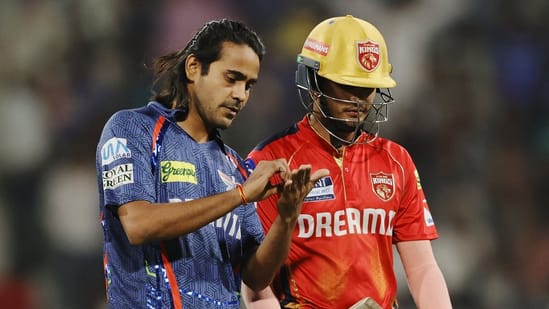Digvijay Singh Rathi’s notebook gesture after dismissing PBKS’ Priyansh Arya cost him 25% of his match fee and a demerit point. The BCCI’s strict action reignites debate about acceptable celebrations in IPL cricket.

The Indian Premier League (IPL) 2025 season has been packed with thrilling performances, but the match between Lucknow Super Giants (LSG) and Punjab Kings (PBKS) at Lucknow’s Ekana Stadium took an unexpected turn when young LSG pacer Digvijay Singh Rathi found himself at the center of a disciplinary storm. The incident occurred during PBKS’ chase when Rathi dismissed rookie batter Priyansh Arya with a well-directed short ball, only to follow it up with a celebration that would cost him dearly—pulling out an imaginary notebook and pen to mockingly “record” the dismissal.
This seemingly playful act quickly escalated into a full-blown controversy, with the Board of Control for Cricket in India (BCCI) taking swift action. Rathi was fined 25% of his match fee and handed one demerit point for breaching the IPL Code of Conduct’s Article 2.5, which prohibits gestures that could provoke aggressive reactions. While the bowler admitted to the offense and accepted the sanctions, the incident has reignited the ongoing debate about where to draw the line between passionate celebration and unsporting behavior in professional cricket.
The match situation itself added layers to the controversy. PBKS, chasing a competitive total, had just begun their innings when the incident occurred in the third over. Rathi’s delivery to Arya was cleverly disguised—short and wide, tempting the young left-hander into a pull shot that resulted in a top-edge safely taken by Shardul Thakur at mid-on. While the dismissal was fairly routine, Rathi’s subsequent notebook pantomime transformed what should have been a moment of sporting triumph into a disciplinary case study.
Cricket historians might note that this isn’t the first time notebook celebrations have caused controversy in sports. Similar gestures have been seen in football and other competitive sports, often interpreted as “taking names” of opponents. However, in cricket’s traditionally gentlemanly context, where respect for opponents remains a cherished value, such displays carry particular weight. The BCCI’s decision to penalize Rathi reflects the league’s commitment to maintaining certain standards of decorum, especially when involving young players like Arya who are still finding their feet in the high-pressure IPL environment.
The reaction from cricket pundits and fans has been predictably divided. Former players aligned with traditional values have largely supported the punishment, arguing that while aggression has its place in modern cricket, targeted mockery of specific players crosses an important line. On social media platforms, younger fans have been more sympathetic to Rathi, viewing his celebration as harmless banter that adds color to the game. This generational divide in perceptions of sportsmanship mirrors broader societal shifts in how we view competitiveness and expression in professional sports.
Looking back at IPL history, this incident joins a growing list of controversial celebrations that have tested the boundaries of acceptable behavior. From Virat Kohli’s famous “silent” gesture towards Gautam Gambhir in 2016 to Rashid Khan’s bat-swinging pantomime in 2021, the league has consistently grappled with balancing player expression against maintaining sportsmanship. What makes Rathi’s case particularly noteworthy is its premeditated nature – unlike spontaneous outbursts of emotion, the notebook celebration appeared calculated, which may have influenced the match referee’s decision.
The philosophical question at the heart of this controversy touches on the very nature of professional sport in the 21st century. As cricket evolves into ever more competitive and commercialized formats, the traditional ideals of sportsmanship are being constantly renegotiated. The IPL, as cricket’s most lucrative and visible domestic competition, finds itself at the forefront of these discussions. While no one wants to see the game lose its competitive edge, there’s growing recognition that maintaining certain standards of respect benefits the sport’s long-term health.
For Digvijay Singh Rathi, this incident serves as a valuable learning experience early in his career. The talented pacer now faces the challenge of channeling his competitive fire in ways that don’t cross disciplinary lines. Meanwhile, Priyansh Arya’s response – or lack thereof – to the incident has shown maturity beyond his years, focusing on his game rather than engaging in public exchanges.
As the IPL 2025 season progresses, this incident will likely serve as a reference point for how on-field behavior is judged. The BCCI’s decisive action sends a clear message about the standards expected from players, while leaving room for the passionate displays that make T20 cricket so electrifying. In the final analysis, the notebook controversy encapsulates the delicate balance modern cricket must strike between maintaining tradition and embracing evolution – a challenge that will only grow as the sport continues to globalize and attract new audiences.
The conversation around sportsmanship in cricket is far from over, and incidents like these ensure it remains at the forefront of discussions about the game’s future. As fans, we’re left to ponder – where should the line be drawn between healthy competition and disrespect, and how can the spirit of cricket be preserved in an increasingly competitive sporting landscape? The answer, much like the game itself, continues to evolve.
